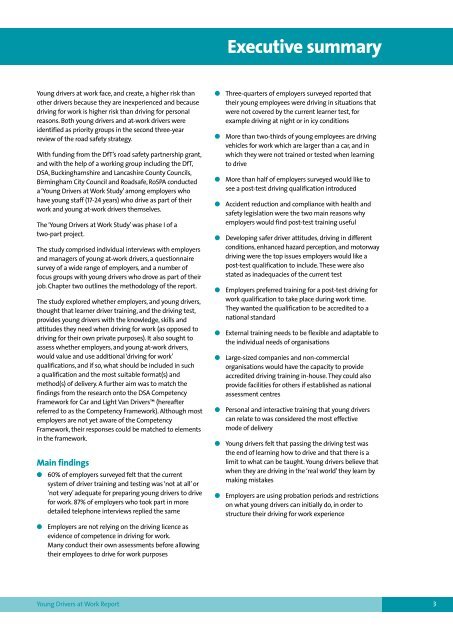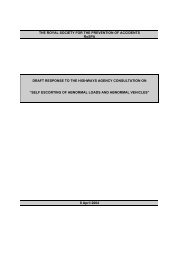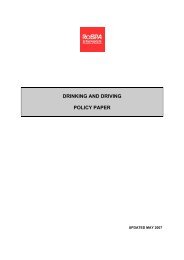RoSPA Young Drivers at Work Report
RoSPA Young Drivers at Work Report
RoSPA Young Drivers at Work Report
Create successful ePaper yourself
Turn your PDF publications into a flip-book with our unique Google optimized e-Paper software.
Executive summary<br />
<strong>Young</strong> drivers <strong>at</strong> work face, and cre<strong>at</strong>e, a higher risk than<br />
other drivers because they are inexperienced and because<br />
driving for work is higher risk than driving for personal<br />
reasons. Both young drivers and <strong>at</strong>-work drivers were<br />
identified as priority groups in the second three-year<br />
review of the road safety str<strong>at</strong>egy.<br />
With funding from the DfT’s road safety partnership grant,<br />
and with the help of a working group including the DfT,<br />
DSA, Buckinghamshire and Lancashire County Councils,<br />
Birmingham City Council and Roadsafe, <strong>RoSPA</strong> conducted<br />
a ‘<strong>Young</strong> <strong>Drivers</strong> <strong>at</strong> <strong>Work</strong> Study’ among employers who<br />
have young staff (17-24 years) who drive as part of their<br />
work and young <strong>at</strong>-work drivers themselves.<br />
The ‘<strong>Young</strong> <strong>Drivers</strong> <strong>at</strong> <strong>Work</strong> Study’ was phase I of a<br />
two-part project.<br />
The study comprised individual interviews with employers<br />
and managers of young <strong>at</strong>-work drivers, a questionnaire<br />
survey of a wide range of employers, and a number of<br />
focus groups with young drivers who drove as part of their<br />
job. Chapter two outlines the methodology of the report.<br />
The study explored whether employers, and young drivers,<br />
thought th<strong>at</strong> learner driver training, and the driving test,<br />
provides young drivers with the knowledge, skills and<br />
<strong>at</strong>titudes they need when driving for work (as opposed to<br />
driving for their own priv<strong>at</strong>e purposes). It also sought to<br />
assess whether employers, and young <strong>at</strong>-work drivers,<br />
would value and use additional ‘driving for work’<br />
qualific<strong>at</strong>ions, and if so, wh<strong>at</strong> should be included in such<br />
a qualific<strong>at</strong>ion and the most suitable form<strong>at</strong>(s) and<br />
method(s) of delivery. A further aim was to m<strong>at</strong>ch the<br />
findings from the research onto the DSA Competency<br />
Framework for Car and Light Van <strong>Drivers</strong> (hereafter<br />
referred to as the Competency Framework). Although most<br />
employers are not yet aware of the Competency<br />
Framework, their responses could be m<strong>at</strong>ched to elements<br />
in the framework.<br />
Main findings<br />
●<br />
●<br />
60% of employers surveyed felt th<strong>at</strong> the current<br />
system of driver training and testing was ‘not <strong>at</strong> all’ or<br />
‘not very’ adequ<strong>at</strong>e for preparing young drivers to drive<br />
for work. 87% of employers who took part in more<br />
detailed telephone interviews replied the same<br />
Employers are not relying on the driving licence as<br />
evidence of competence in driving for work.<br />
Many conduct their own assessments before allowing<br />
their employees to drive for work purposes<br />
●<br />
●<br />
●<br />
●<br />
●<br />
●<br />
●<br />
●<br />
●<br />
●<br />
●<br />
Three-quarters of employers surveyed reported th<strong>at</strong><br />
their young employees were driving in situ<strong>at</strong>ions th<strong>at</strong><br />
were not covered by the current learner test, for<br />
example driving <strong>at</strong> night or in icy conditions<br />
More than two-thirds of young employees are driving<br />
vehicles for work which are larger than a car, and in<br />
which they were not trained or tested when learning<br />
to drive<br />
More than half of employers surveyed would like to<br />
see a post-test driving qualific<strong>at</strong>ion introduced<br />
Accident reduction and compliance with health and<br />
safety legisl<strong>at</strong>ion were the two main reasons why<br />
employers would find post-test training useful<br />
Developing safer driver <strong>at</strong>titudes, driving in different<br />
conditions, enhanced hazard perception, and motorway<br />
driving were the top issues employers would like a<br />
post-test qualific<strong>at</strong>ion to include. These were also<br />
st<strong>at</strong>ed as inadequacies of the current test<br />
Employers preferred training for a post-test driving for<br />
work qualific<strong>at</strong>ion to take place during work time.<br />
They wanted the qualific<strong>at</strong>ion to be accredited to a<br />
n<strong>at</strong>ional standard<br />
External training needs to be flexible and adaptable to<br />
the individual needs of organis<strong>at</strong>ions<br />
Large-sized companies and non-commercial<br />
organis<strong>at</strong>ions would have the capacity to provide<br />
accredited driving training in-house. They could also<br />
provide facilities for others if established as n<strong>at</strong>ional<br />
assessment centres<br />
Personal and interactive training th<strong>at</strong> young drivers<br />
can rel<strong>at</strong>e to was considered the most effective<br />
mode of delivery<br />
<strong>Young</strong> drivers felt th<strong>at</strong> passing the driving test was<br />
the end of learning how to drive and th<strong>at</strong> there is a<br />
limit to wh<strong>at</strong> can be taught. <strong>Young</strong> drivers believe th<strong>at</strong><br />
when they are driving in the ‘real world’ they learn by<br />
making mistakes<br />
Employers are using prob<strong>at</strong>ion periods and restrictions<br />
on wh<strong>at</strong> young drivers can initially do, in order to<br />
structure their driving for work experience<br />
<strong>Young</strong> <strong>Drivers</strong> <strong>at</strong> <strong>Work</strong> <strong>Report</strong><br />
3
















